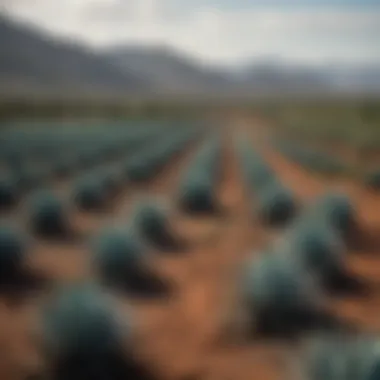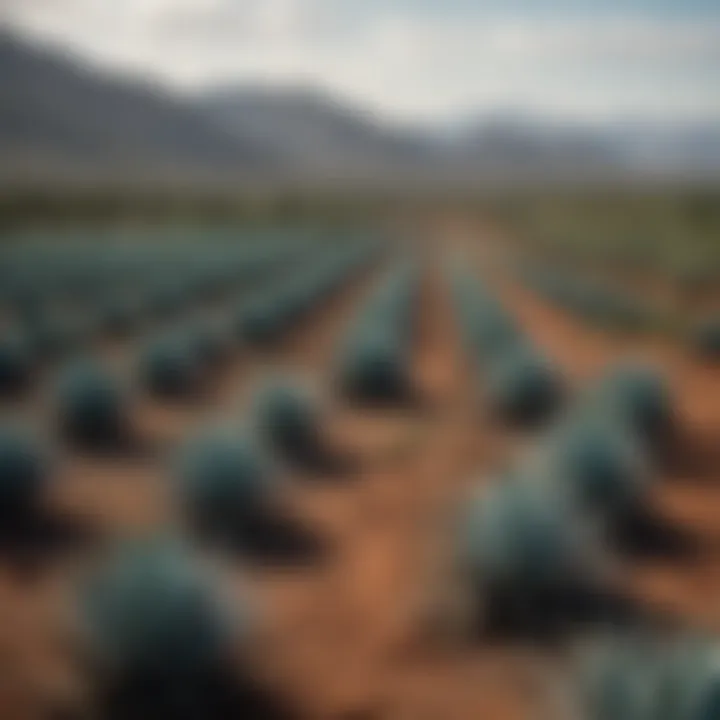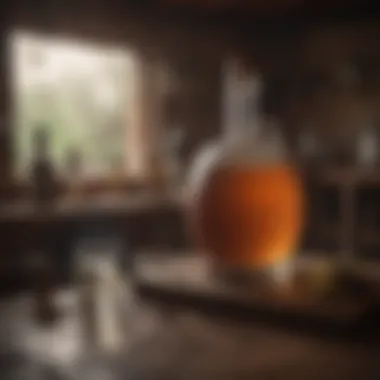An In-Depth Exploration of Tequila and Mezcal


Intro
Tequila and mezcal are two renowned spirits from Mexico, often confused yet distinctly different. The rich heritage and intricate production processes behind these beverages offer a glimpse into Mexico's cultural tapestry. This article aims to dissect the various types of both spirits, examining their classifications, flavors, regional differences, and more. By highlighting what sets tequila apart from mezcal, we hope to provide readers with a deeper understanding of these iconic drinks.
Recipe Overview
While we will not discuss a specific dish or recipe in the traditional sense, understanding how to appreciate tequila and mezcal is crucial. Each spirit carries its own character and complexity, inviting enthusiasts to explore beyond standard consumption. The primary focus will be on the flavors and production methods that define each type.
Distillation Techniques and Production
Both tequila and mezcal undergo fermentation and distillation, but the processes vary significantly. Tequila is predominantly made from the blue agave plant, particularly in the region of Jalisco. Mezcal, on the other hand, can be produced from many different types of agave.
Tequila Production Process
- Harvesting - The blue agave plant is harvested, usually after 8 to 12 years of growth.
- Cooking - The piñas, or hearts, are cooked in ovens or autoclaves, converting the starches to sugars.
- Milling - The cooked piñas are then crushed to extract the juices.
- Fermentation - Yeast is added to the juice, fermenting it into alcohol.
- Distillation - The liquid undergoes distillation, typically twice, to achieve higher purity.
Mezcal Production Process
- Harvesting - Various agave types are harvested, often by hand.
- Cooking - The agave hearts are roasted in underground pits, imparting a smoky flavor.
- Milling - The cooked agave is crushed, sometimes with a stone wheel.
- Fermentation - Natural fermentation occurs, utilizing wild yeasts.
- Distillation - Mezcal is usually distilled twice, enhancing the unique flavor profile.
Flavor Profiles
Understanding the flavor profiles of tequila and mezcal is essential for appreciation.
- Tequila is smooth, often with notes of citrus, pepper, and sweetness. Varieties like Blanco offer fresh agave taste, while Añejo provides complex flavors from more extended barrel aging.
- Mezcal is complex, with a distinct smoky characteristic. It may present earthy, fruity, or spicy notes depending on the type of agave used.
Regional Variations
Both spirits are deeply tied to their regions of production:
- Tequila is primarily produced in Jalisco, but certain states like Guanajuato and Tamaulipas also produce it.
- Mezcal is mostly linked with Oaxaca but can be found in states like Durango and San Luis Potosí.
By exploring these regional nuances, one can appreciate the artisan craftsmanship that goes into each bottle.
Cultural Significance
Tequila and mezcal are more than just beverages; they hold cultural significance in Mexican society. They are often associated with celebrations, traditions, and rituals. The production methods reflect a connection to the land and the heritage of the artisans who craft them.
"Tequila is liquid history. It speaks to the land, the people, and the traditions that have shaped it through generations."
Prolusion to Tequila and Mezcal
Tequila and mezcal hold significant places in the world of spirits, not only for their unique flavors but also for their rich histories and cultural connections. Understanding these spirits will enhance your appreciation for them and provide context for the enjoyment of tequila and mezcal. This article will delve into the various types, production processes, and cultural significance of these two beverages.
Historical Background
The origins of tequila and mezcal date back centuries, with roots deeply embedded in Mexican culture. The agave plant, crucial for both spirits, is indigenous to the region. Evidence suggests that people in Mexico began fermenting agave as far back as 1000 BC. Initially, pulque, a fermented drink made from agave, was the beverage of choice for indigenous cultures.
In the 16th century, Spanish colonizers introduced distillation techniques. This led to the creation of mezcal, a broader category of spirits made from different agave varieties. Tequila, which specifically comes from the blue agave plant, emerged around the 18th century. Today, tequila can only be produced in specific regions of Mexico, primarily in Jalisco.
The distinction between tequila and mezcal is not just geographical; it also relates to the type of agave used, production methods, and flavor profiles.
Cultural Significance
Tequila and mezcal are not just drinks but cultural symbols in Mexico. They represent tradition, celebration, and even ritual. In various Mexican celebrations, such as weddings or Day of the Dead, these spirits are integral. They embody the social fabric of communities, often enjoyed during gatherings.


Moreover, the production of these spirits is considered an art form. Many distilleries, or "palomas," have been passed down through generations. The dedication to traditional methods ensures that the spirit retains its authentic character. This connection to cultural heritage adds immense value, creating more than just a drink but a narrative that transcends time.
Focusing on tequila and mezcal allows readers to explore a vibrant aspect of Mexican culture, enriching their knowledge and experience. The craftsmanship, history, and significance of these spirits make them deserving of an in-depth examination.
What is Tequila?
Tequila is one of Mexico’s most recognized spirits, a category of alcoholic beverage with strict legal definitions and production standards. Understanding tequila entails grasping its origins, ingredients, and the processes that define its unique qualities. This section will provide clarity on tequila’s legal definitions and the agave plants that contribute to its distinctive character. Both elements play a crucial role in differentiating tequila from other spirits, including mezcal, and highlight its cultural and economic significance within Mexico.
Legal Definitions
Tequila enjoys a protected designation of origin status, which means that only spirits produced within specific geographic regions in Mexico can legally be called tequila. The primary region is Tequila, located in the state of Jalisco, although other areas are also authorized. Furthermore, tequila must be made from at least 51% blue agave. This means that other sugars may be added, but they cannot exceed that threshold. The exact definition aligns with Mexican law and international agreements on geographical indications.
In terms of classifications, tequila is divided into two main categories: 100% agave tequila and mixto. 100% agave tequila is produced solely from blue agave, while mixto tequila can include other sugar sources. Each category comes with its own standards for flavor, quality, and production methods.
Types of Agave Used
Tequila primarily utilizes the blue agave plant, scientifically known as Agave tequilana. This particular species is favored for its high sugar content, making it suitable for fermentation into alcohol. The growth cycle of blue agave can range from six to ten years, depending on cultivation conditions, before it is harvested.
The choice of growing conditions and specific agave types can impact the flavor profile of the tequila. Factors like soil quality, sunlight, and rainfall contribute significantly to the agave's maturation. Additionally, while blue agave is the sole agave used for tequila production, variations exist within this species, which can lead to diverse flavor outcomes.
Understanding these factors is important for those seeking to appreciate the subtleties of tequila. The controlled growth and preparation methods reflect the craftsmanship and care that goes into producing high-quality tequila, enriching its overall narrative.
"Tequila is not just a drink; it represents a cultural heritage shaped over generations."
As a result, the careful selection and treatment of agave underscore the importance of authenticity in each bottle of tequila.
Types of Tequila
Understanding the types of tequila is essential when diving into the world of this Mexican spirit. Each type exhibits distinct characteristics shaped by its aging process and production methods. This section serves to clarify the differences among the varieties, enabling consumers to make informed choices. Various types of tequila cater to different palates, making it possible for anyone to discover a flavor profile that resonates with their taste.
Blanco (Silver) Tequila
Blanco tequila, also known as silver tequila, is typically bottled immediately after distillation or aged for less than two months. It is pure and unaged, capturing the essence of the agave plant. This type stands out for its clear appearance and vibrant flavors. The aroma is fresh and herbaceous, often accompanied by a slight hint of pepper and citrus. Because of its unaltered form, blanco tequila is favored in cocktails like margaritas and palomas. Many also enjoy it straight to appreciate its robust and natural agave characteristics.
Reposado Tequila
Reposado translates to "rested," which signifies that this tequila is aged between two months and one year in wooden barrels. This aging process imparts subtle flavors and a golden hue, making reposado a versatile choice for both sipping and mixing. The wood influence adds layers of complexity, including notes of vanilla, caramel, and spices. The slight mellowness makes it suitable for those who appreciate a smoother experience without losing the distinct agave flavor.
Añejo Tequila
Añejo tequila is aged for a minimum of one year but less than three years. The extended aging period enhances the flavor profile significantly, developing rich notes of oak, chocolate, and dried fruits. Añejo is often enjoyed neat or on the rocks, allowing drinkers to savor its complexity. This type is ideal for those who enjoy spirits with depth and character, often served as a special treat or after a meal.
Extra Añejo Tequila
Extra Añejo represents the pinnacle of tequila aging, requiring a minimum of three years in barrels. This extended maturation yields a luxurious product, rich in flavors and aromas. The result is often likened to fine whiskey, with pronounced notes of dark chocolate, roasted coffee, and rich spices. Extra Añejo is best sipped slowly to appreciate its elaborate profile. Its rarity and craftsmanship also make it a coveted choice for collectors and enthusiasts alike.
Cristalino Tequila
Cristalino tequila is a relatively recent addition to the tequila family. It begins life as añejo or extra añejo but undergoes additional filtration to remove color while retaining the complex flavors developed during aging. The outcome is a clear tequila with a light mouthfeel and flavors reminiscent of fine añejo, suited for those who enjoy the richness without the darker appearance. This type is becoming increasingly popular, appealing to trendsetters and traditionalists alike.
What is Mezcal?
Mezcal is a traditional Mexican spirit that has gained prominence in recent years, distinct from tequila. It is made from the agave plant, but unlike tequila, which primarily uses the blue agave, mezcal can be produced from a variety of agave types. This diversity contributes to a wide range of flavor profiles, making mezcal unique in its own right. Its importance stems from both cultural heritage and its evolving place in the global beverage market. Understanding mezcal offers insight into regional practices and traditional craftsmanship tied to production.
Legal Definitions
The legal definition of mezcal is crucial for distinguishing it from other agave-based spirits. According to Mexican regulations, mezcal must be made in designated regions, primarily Oaxaca, with a minimum of 80% agave content. The specific types of agave used can greatly influence the characteristics of the final product. Furthermore, the production process may involve traditional methods such as roasting agave hearts in earthen pits, adding to its distinctive smoky flavor.


Types of Agave Used
In contrast to tequila, which is predominantly derived from blue agave, mezcal utilizes various species of agave including Espadín, Tobalá, and Jabalí. Each agave type contributes unique characteristics:
- Espadín: The most common type used for mezcal, widely cultivated. It produces a balanced flavor with earthy and fruity notes.
- Tobalá: This wild agave offers a more delicate and complex taste, making it a favored choice for enthusiasts.
- Jabalí: Rare and sought after, Jabalí has a robust and intense flavor profile, rich in wild herbal notes.
- Tepeztate: Known for its long maturation process, Tepeztate brings bold flavors and can create an exceptional spirit when distilled.
The variety of agave used in mezcal illustrates the adaptability of Mexican traditions in spirit production, emphasizing the rich biodiversity of the region.
Mezcal is more than just a drink; it embodies history, culture, and sustainability, making it an essential part of Mexico's heritage.
Types of Mezcal
In the world of spirits, mezcal holds a place of distinction due to its unique production methods and diverse flavor profiles. Understanding the types of mezcal is crucial for connoisseurs and casual drinkers alike. It allows individuals to appreciate the nuances that differentiate one mezcal from another. Each type reflects the specific agave used, the region of production, and the artisanal techniques employed by the distillers. This section will explore five notable types of mezcal: Espadín, Tobala, Bicuishe, Jabalí, and Tepeztate.
Espadín Mezcal
Espadín mezcal is perhaps the most recognized type of mezcal. It is made predominantly from the Agave espadín plant, which accounts for over 80% of all mezcal production. Its accessibility contributes to its popularity, both in Mexico and internationally. The flavor profile of Espadín is often described as balancing smokiness with sweet and herbal notes. This type varies considerably based on the distillation methods and the local terroir. Some producers use traditional clay pots, while others opt for stainless steel. The choice of production method can influence the overall taste significantly.
Tobala Mezcal
Tobala mezcal is made using the Agave tobala, a wild agave that thrives in higher altitudes. Tobala is smaller in size and takes much longer to mature compared to Espadín. This contributes to its rarity and often higher price point. The flavor of Tobala mezcal is typically richer and more complex. It can exhibit earthy tones with floral and fruity undertones. Additionally, each bottle can present a distinct profile, making Tobala a prized offering among spirits enthusiasts.
Bicuishe Mezcal
Produced from the Agave bicuishe, this variety is often less common compared to Espadín and Tobala. Bicuishe mezcal typically carries herbal and fruity characteristics, with a hint of sweetness. It is known for a smooth finish that can linger pleasantly on the palate. Due to its unique terroir, the production of Bicuishe mezcal might also experience variations based on the specific growing conditions in the region where it is cultivated. It’s an exceptional choice for those seeking something out of the ordinary.
Jabalí Mezcal
The Agave jabalí is considered one of the most elusive agaves used in mezcal production. Jabalí plants are challenging to cultivate and are often only found in Oaxaca. The mezcal made from Jabalí tends to be potent, with bold flavors that you will not forget. Expect a robust smokiness complemented by complex tastes such as wild herbs and spices. The rarity and unique flavor profile make Jabalí a specialty among mezcal aficionados.
Tepeztate Mezcal
Tepeztate mezcal is created from the Agave tepeztate, another wild agave species. It grows slowly and can take up to 25 years to mature. The resulting mezcal is known for its deep and complex flavors. Tepeztate offers a remarkable mix of earthy, herbal, and floral notes, often with a touch of sweetness. This mezcal is a testament to the patience and skill of its makers, as well as the unique environmental factors that influence its growth.
Understanding the different types of mezcal enhances the appreciation of this traditional spirit. Each type offers myriad flavors and experiences, structured by the unique attributes of the agave and the artistry of the distiller.
Recognizing the breadth of mezcal types enriches the tasting experience. It also supports informed choices when selecting the spirit for personal enjoyment or gatherings.
Comparative Analysis of Tequila and Mezcal
Understanding the differences between tequila and mezcal is essential for appreciation of these unique spirits. Both have strong cultural roots and distinctive production methods. This comparative analysis highlights the nuances that often go unnoticed by casual consumers but are significant to aficionados and connoisseurs.
Production Processes
The production of tequila and mezcal differs in several key ways, which significantly affect the final product. Tequila primarily uses the Blue Weber agave. The production usually takes place in specifically designated regions like Jalisco. The core of the agave, known as the piña, is steamed in industrial ovens, then crushed to extract the sugary juice. Fermentation follows, typically using natural yeasts.
In contrast, mezcal can be made from a variety of agave species, up to fifty different types. The production often involves a more traditional method. The agave heart is roasted in underground pits, giving mezcal its distinctive smoky flavor. The fermentation process can also vary, incorporating wild yeasts or even residual sugars from previous batches, which enriches the complexity of flavors in mezcal.
Flavor Profiles
Flavor profiles highlight the essence of both beverages. Tequila is known for its crisp, clean taste, often characterized by hints of citrus and earthy agave tones. Depending on the type of tequila, you may also detect notes of vanilla or spice, especially in aged variants like Reposado or Añejo.
Mezcal, however, offers a broader range of flavors due to the variety of agaves used and the production methods. The cooking process creates a smoky aroma and can produce flavors ranging from sweet to savory. Many describe it as more complex and earthy compared to tequila, frequently appreciating its diversity through the distinction of terroir. Each agave type brings out different characteristics, from fruity to herbal and even floral notes.
Regional Variations
Geography plays a vital role in both spirits. Tequila is tightly regulated and must come from specific regions in Mexico. Moreover, the environment in Jalisco and surrounding states leads to a consistent profile in tequila.


Mezcal has a broader geographical reach, primarily sourced from Oaxaca, though it can also originate from other states like Durango and San Luis Potosí. Each region contributes unique traits to its mezcal. For instance, Oaxaca mezcals often carry intense smokiness, while Durango showcases a sweeter profile.
As a result, the nuances of flavor and aroma can vary significantly with the geographic source, adding depth to your tasting experience.
"Understanding these distinctions enhances appreciation and aids in making informed choices when selecting spirits for enjoyment or collection."
The Role of Terroir
The concept of terroir is crucial in understanding the distinctive characteristics of both tequila and mezcal. Terroir refers to the unique environmental factors that affect the way agave plants grow, ultimately influencing the flavor profiles of the spirits produced from them. This includes soil composition, climate, elevation, and specific growing conditions. These elements not only shape the plants themselves but also dictate the methods used in distillation and aging, leading to significant differences in taste between various products.
Terroir emphasizes the notion that the essence of a spirit can reflect its origin. For tequila, which must be made from blue agave in specific regions of Mexico, the conditions can greatly affect sweetness and earthiness of the drink. Mezcal, being produced from over thirty different types of agave, displays an even broader diversity of flavors governed by its terroir. Understanding these factors allows consumers to better appreciate the craftsmanship involved in each bottle.
Impact of Soil and Climate
Soil health plays an essential role in agave cultivation. Well-drained, volcanic soils are often considered most favorable for growing blue agave. These soils can leverage minerals that enhance the flavor profile of tequila. Similarly, mescal agave, growing in arid climates, experiences stress that can intensify its flavor compounds, yielding unique tasting notes.
Climate is another significant factor. The specific temperature ranges and rainfall patterns affect how fast the agave matures. For example, higher elevation regions provide cooler temperatures which can slow the growth of agave, allowing for more concentrated flavors. Over time, these climate variations create distinct terroirs that contribute to the overarching identity of each spirit.
Agave Maturation Conditions
Maturation conditions involve not just the age of the agave plant but also the environmental factors that influence its flavor as it grows. Agaves generally require 7 to 10 years to reach maturation. During this period, factors like sunlight exposure and microclimates can immensely impact the plant's chemical composition.
Higher light exposure might boost sugar content and impart a more robust flavor. Conversely, areas that receive rainfall may cultivate softer, sweeter notes. After harvest, how the piñas are processed—steam-heating versus traditional pit-roasting—further adds to the spirit’s terroir-based characteristics.
In summary, the role of terroir in both tequila and mezcal is not just a footnote in production. It is foundational to understanding what makes each spirit unique and worthy of appreciation. The relationship between agave, its environment, and the craftsmanship of distillers results in tasting experiences that showcase the rich biodiversity and cultural significance of these Mexican spirits.
Sustainability and Ethical Considerations
In the context of tequila and mezcal production, the concepts of sustainability and ethical considerations have gained significant attention. These factors not only influence the quality of the spirits but also reflect a growing awareness about environmental preservation and social responsibility within the industry. As both tequila and mezcal have taken on global appeal, it becomes essential to evaluate how they are produced and the impact these practices have on the agave landscape.
Agave Farming Practices
Agave plants, particularly the Blue Weber agave for tequila and various species for mezcal, require specific farming practices to ensure their sustainability. Traditional methods of cultivation involve planting agave in organic soil, free from harmful pesticides and fertilizers.
Some farmers adopt polyculture methods, mixing agave with other plants. This practice helps in maintaining soil fertility and reducing pests naturally. By doing so, farmers not only protect the agave plants but also promote biodiversity in the ecosystem. Another important practice is rotational grazing, which allows soil to replenish and prevents erosion. However, many commercial agave farms still rely on monoculture, which can lead to serious ecological consequences.
Additionally, there is a pressing need for agave farming to prioritize sustainable harvesting techniques. Overharvesting has become a risk due to increasing demand for tequila and mezcal. This jeopardizes the growth cycle of agave plants, some of which take years to mature. Sustainable practices ensure that farmers do not harvest their crops too soon, allowing the plants to thrive and maintain balance in the local environment.
Environmental Impact
The environmental impact of tequila and mezcal production includes several factors ranging from land usage to water consumption. Large-scale agave farming has been linked to deforestation and habitat destruction. Land is often cleared for agave plantations, which can disrupt local ecosystems and affect wildlife.
Water usage also raises concerns, especially in arid regions where agave is often planted. Some areas have reported significant water depletion due to intensive irrigation practices. With water scarcity becoming a critical global issue, it is important for producers to adopt more efficient irrigation techniques, such as drip irrigation, which minimizes water waste.
Furthermore, the production process itself—specifically the cooking and fermentation stages—can contribute to carbon emissions. Distilleries that prioritize energy efficiency and utilize renewable energy sources can lessen their carbon footprint.
"Sustainable practices not only benefit the environment but also support the quality and integrity of the spirits produced."
The End
The conclusion of this article is a vital component as it encapsulates the essence of what has been discussed throughout the exploration of tequila and mezcal. Both spirits hold significant cultural and historical importance, extending beyond mere beverages to embody the traditions and practices of Mexican people. Understanding the unique characteristics and process of production is crucial for any enthusiast.
In considering tequila and mezcal, it is essential to recognize their distinct identities while also appreciating the commonality they share as agave-based spirits. Each type offers unique flavor profiles influenced by factors such as agave variety, production methods, and regional differences. For those looking to deepen their knowledge or simply enjoy these spirits, the insights provided in this article can help enhance their experience.
Final Thoughts on Tequila and Mezcal
The journey through the various types of tequila and mezcal allows one to appreciate the craftsmanship involved in creating these spirits. By prioritizing sustainable practices and understanding the impact of terroir, consumers can make more informed choices that benefit the environment as well as local communities.
Recognizing the diverse range of options is key when selecting a spirit. From the crisp and fresh notes of Blanco tequila to the complex layers found in Añejo mezcal, each choice presents its own story and set of flavors to be explored. Those who engage with tequila and mezcal beyond the surface can uncover a rich world of tastes and cultural significance that elevate the drinking experience.
"The beauty of tequila and mezcal lies not just in their flavor, but in the heritage they carry and the stories they tell."
Ultimately, the exploration of tequila and mezcal is not just a casual pursuit; it is an invitation to delve into a cultural legacy marked by tradition, innovation, and a commitment to craftsmanship. As the appreciation for these spirits expands globally, it brings with it an opportunity to engage with the artisans and history that shape them. For lovers of fine spirits, the knowledge gained from this article should encourage a deeper connection to the drink and the people behind it.







